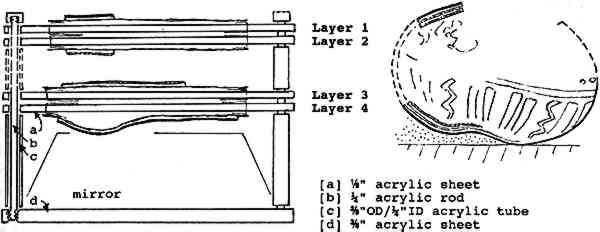FROM CODEX TO CALABASH: RECOVERY OF A PAINTED ORGANIC ARTIFACT FROM THE ARCHAEOLOGICAL SITE OF CER�N, EL SALVADORHARRIET F. BEAUBIEN
7 MOUNTING FOR TRANSPORT, DISPLAY, AND STORAGEConsiderations for mounting the fragmentary remains of Cer�n's painted calabash included the need to provide ample physical protection with a simple yet flexible design utilizing stable and reversible materials. These factors were of particular importance given staff limitations and lack of environmental controls in El Salvador's museums. Rather than presenting the remains in an interpretive reassembly of the object, the mount was designed more neutrally to reproduce the as-found, collapsed state of the object, as some questions still remained about its exact dimensions, curvature, and the full reconstruction of the upper two layers (fig. 6). An assumption was made that the viewer would want to see the painted side of the layers, even if they were originally oriented paint side down (such as layer 4). Information gleaned from the treatment could be presented using photographs, diagrams, and painted facsimiles, which would provide a more coherent interpretation than could the remains themselves.
The mount consists of a series of equal-sized Plexiglas acrylic sheets, each of which supports an individual paint layer. The paint layers were prepared by reinforcing the Japanese tissue backings with additional layers of Pellon 6800 polyester web, adhered with Acryloid B-72 (20% w/v in acetone). The backing was then trimmed to a uniform For display, the sheets can be stacked with the decorated layer (layer 4) in its inverted, as-found orientation (fig. 7); a mirror mounted below allows the layer to be viewed. Varied spacing and arrangement of sheets may be accommodated by altering the length of acrylic rods and tubes, which act as spacers as well as supports for the individual layers; alternatively, the sheets may be disassembled and displayed side by side. To minimize handling and provide maximum protection in storage and during transport, each paint layer is held securely in a sturdy Fome-Cor mat with a deep well. These mats stack into a clamshell box made of acid-free cardboard along with a box containing the display mount components. |
